brake KIA PICANTO 2008 Owners Manual
[x] Cancel search | Manufacturer: KIA, Model Year: 2008, Model line: PICANTO, Model: KIA PICANTO 2008Pages: 335, PDF Size: 12.98 MB
Page 8 of 335
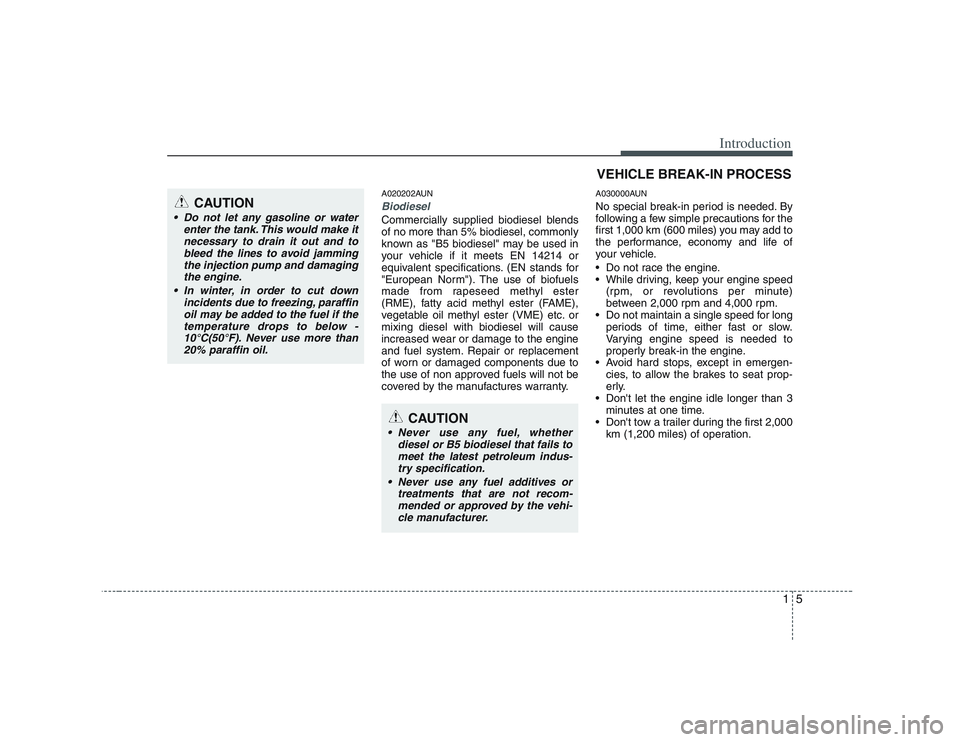
15
Introduction
A020202AUN
Biodiesel
Commercially supplied biodiesel blends of no more than 5% biodiesel, commonly
known as "B5 biodiesel" may be used in
your vehicle if it meets EN 14214 or
equivalent specifications. (EN stands for
"European Norm"). The use of biofuels
made from rapeseed methyl ester
(RME), fatty acid methyl ester (FAME),
vegetable oil methyl ester (VME) etc. ormixing diesel with biodiesel will cause
increased wear or damage to the engine
and fuel system. Repair or replacement
of worn or damaged components due to
the use of non approved fuels will not be
covered by the manufactures warranty.A030000AUN
No special break-in period is needed. By
following a few simple precautions for the
first 1,000 km (600 miles) you may add to
the performance, economy and life of
your vehicle.
Do not race the engine.
While driving, keep your engine speed
(rpm, or revolutions per minute)
between 2,000 rpm and 4,000 rpm.
Do not maintain a single speed for long
periods of time, either fast or slow.
Varying engine speed is needed to
properly break-in the engine.
Avoid hard stops, except in emergen- cies, to allow the brakes to seat prop-
erly.
Don't let the engine idle longer than 3
minutes at one time.
Don't tow a trailer during the first 2,000
km (1,200 miles) of operation.
VEHICLE BREAK-IN PROCESS
CAUTION
Do not let any gasoline or water
enter the tank. This would make itnecessary to drain it out and to
bleed the lines to avoid jamming the injection pump and damaging the engine.
In winter, in order to cut down incidents due to freezing, paraffin
oil may be added to the fuel if thetemperature drops to below - 10°C(50°F). Never use more than
20% paraffin oil.
CAUTION
Never use any fuel, whether diesel or B5 biodiesel that fails tomeet the latest petroleum indus-
try specification.
Never use any fuel additives or treatments that are not recom-
mended or approved by the vehi-cle manufacturer.
Page 9 of 335
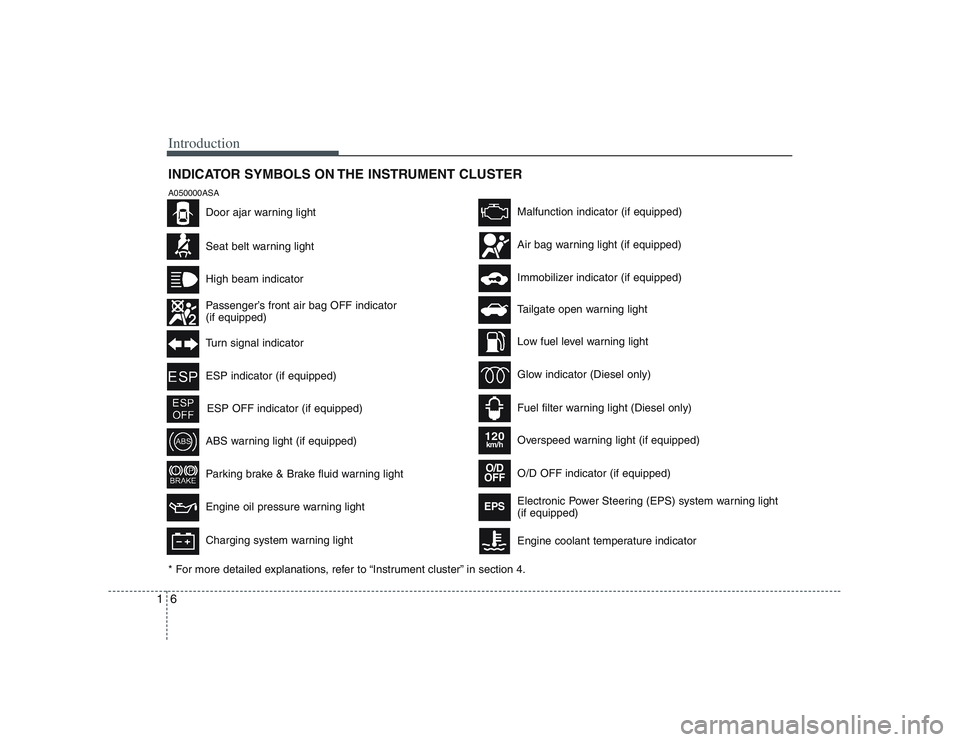
Introduction
6
1
INDICATOR SYMBOLS ON THE INSTRUMENT CLUSTER
Seat belt warning light
High beam indicator
Passenger’s front air bag OFF indicator (if equipped)
Turn signal indicator
ABS warning light (if equipped)
Parking brake & Brake fluid warning light
Engine oil pressure warning light
ESP indicator (if equipped)
ESP OFF indicator (if equipped)
Malfunction indicator (if equipped)
Air bag warning light (if equipped)
Immobilizer indicator (if equipped)
Low fuel level warning light
Glow indicator (Diesel only)
Fuel filter warning light (Diesel only)
* For more detailed explanations, refer to “Instrument cluster” in section 4.
Charging system warning light
A050000ASA
Door ajar warning light
Overspeed warning light (if equipped)
120km/h
Tailgate open warning light O/D OFF indicator (if equipped)
O/D
OFF
Electronic Power Steering (EPS) system warning light (if equipped) EPS
Engine coolant temperature indicator
Page 12 of 335
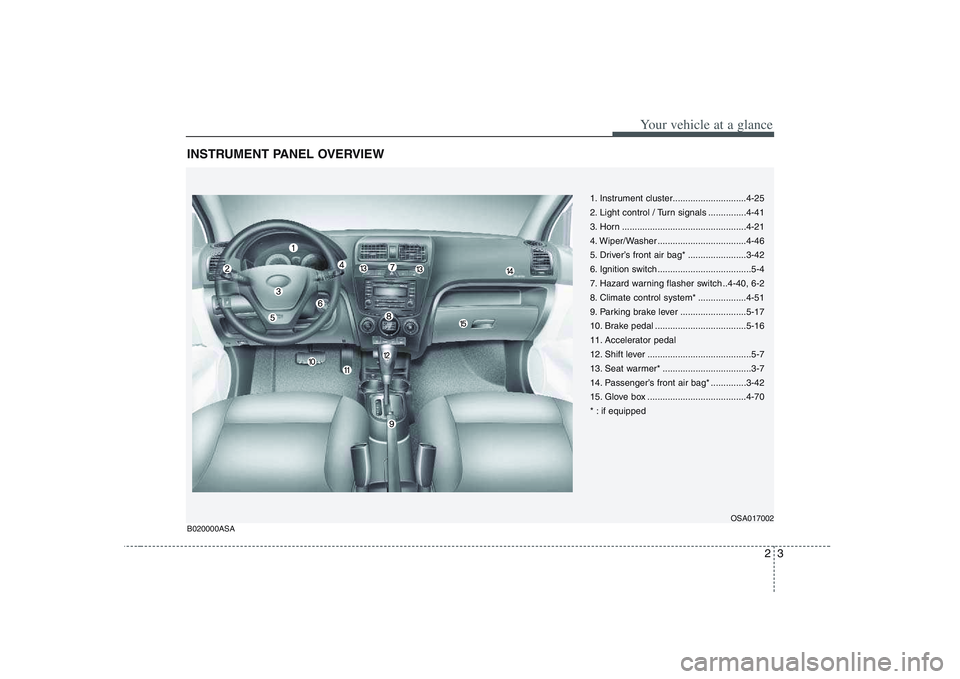
23
Your vehicle at a glance
INSTRUMENT PANEL OVERVIEW
1. Instrument cluster.............................4-25
2. Light control / Turn signals ...............4-41
3. Horn .................................................4-21
4. Wiper/Washer ...................................4-46
5. Driver’s front air bag* .......................3-42
6. Ignition switch .....................................5-4
7. Hazard warning flasher switch ..4-40, 6-2
8. Climate control system* ...................4-51
9. Parking brake lever ..........................5-17
10. Brake pedal ....................................5-16
11. Accelerator pedal
12. Shift lever .........................................5-7
13. Seat warmer* ...................................3-7
14. Passenger’s front air bag* ..............3-42
15. Glove box .......................................4-70
* : if equippedOSA017002
B020000ASA
Page 13 of 335
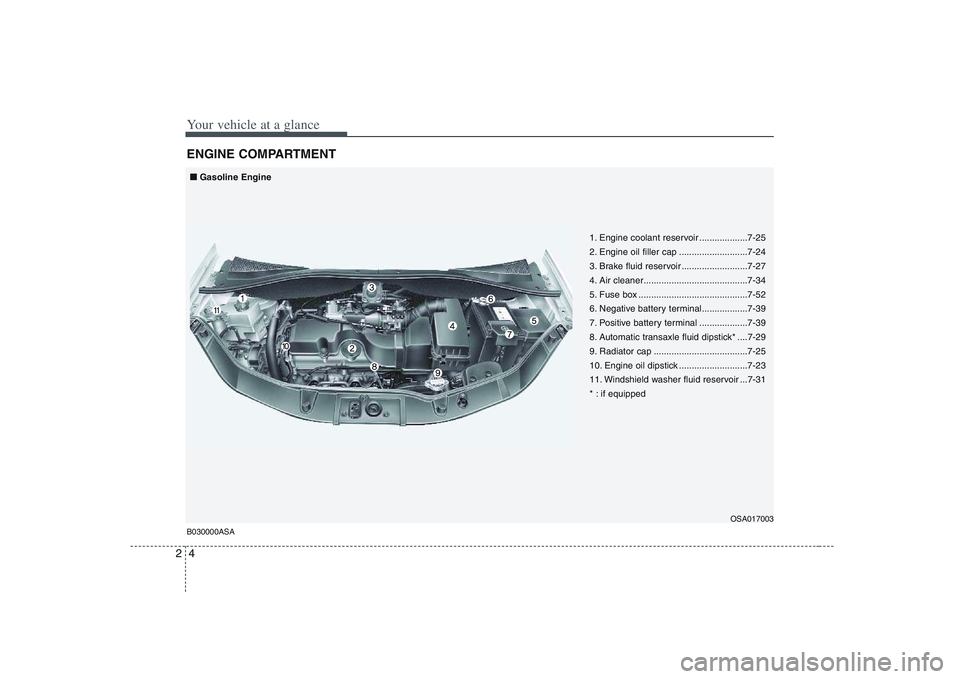
Your vehicle at a glance
4
2
ENGINE COMPARTMENT B030000ASA
OSA017003
■■
Gasoline Engine
1. Engine coolant reservoir ...................7-25
2. Engine oil filler cap ...........................7-24
3. Brake fluid reservoir ..........................7-27
4. Air cleaner.........................................7-34
5. Fuse box ...........................................7-52
6. Negative battery terminal..................7-39
7. Positive battery terminal ...................7-39
8. Automatic transaxle fluid dipstick* ....7-29
9. Radiator cap .....................................7-25
10. Engine oil dipstick ...........................7-23
11. Windshield washer fluid reservoir ...7-31
* : if equipped
Page 14 of 335
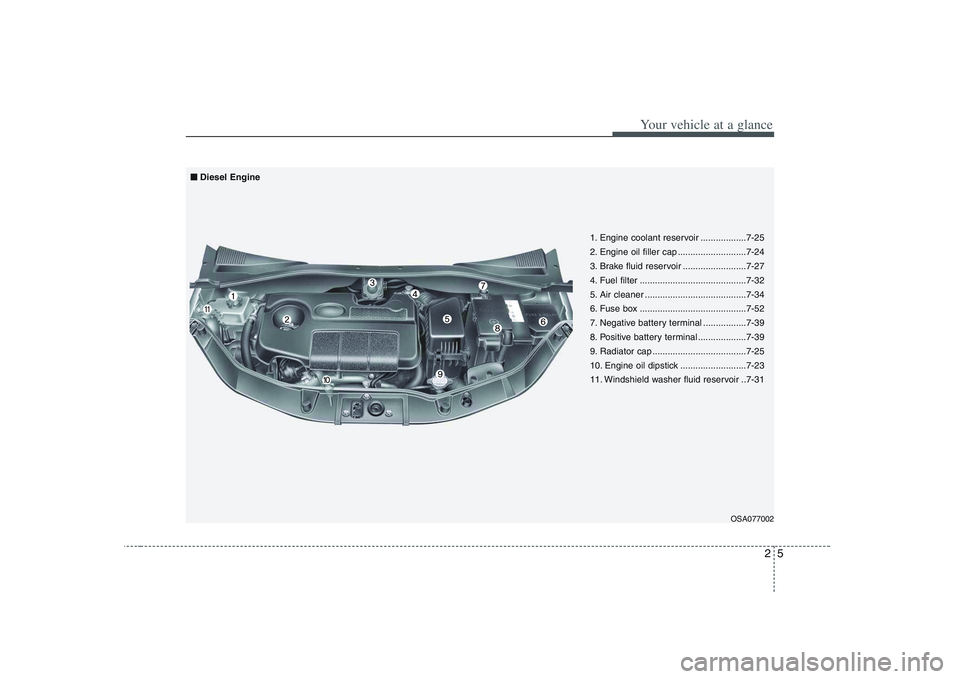
25
Your vehicle at a glance
OSA077002
■
■
Diesel Engine
1. Engine coolant reservoir ..................7-25
2. Engine oil filler cap ...........................7-24
3. Brake fluid reservoir .........................7-27
4. Fuel filter ..........................................7-32
5. Air cleaner ........................................7-34
6. Fuse box ..........................................7-52
7. Negative battery terminal .................7-39
8. Positive battery terminal ...................7-39
9. Radiator cap .....................................7-25
10. Engine oil dipstick ..........................7-23
11. Windshield washer fluid reservoir ..7-31
Page 28 of 335
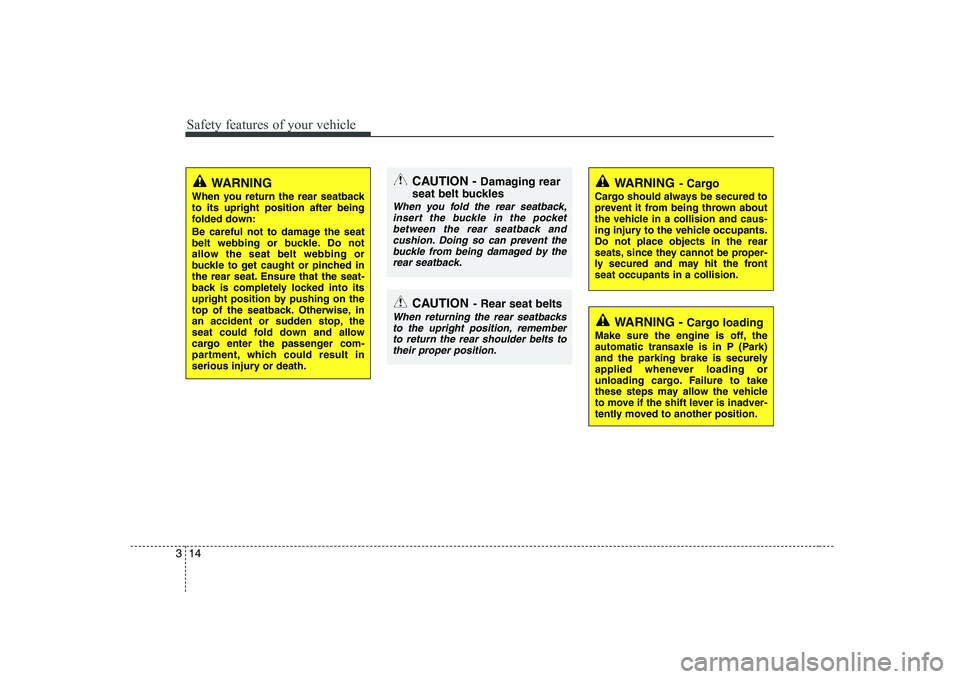
Safety features of your vehicle
14
3
WARNING
When you return the rear seatback to its upright position after being
folded down:
Be careful not to damage the seat
belt webbing or buckle. Do not
allow the seat belt webbing or
buckle to get caught or pinched in
the rear seat. Ensure that the seat-
back is completely locked into its
upright position by pushing on the
top of the seatback. Otherwise, in
an accident or sudden stop, the
seat could fold down and allow
cargo enter the passenger com-
partment, which could result in
serious injury or death.
CAUTION - Rear seat belts
When returning the rear seatbacks
to the upright position, rememberto return the rear shoulder belts totheir proper position.
CAUTION - Damaging rear
seat belt buckles
When you fold the rear seatback, insert the buckle in the pocketbetween the rear seatback andcushion. Doing so can prevent the
buckle from being damaged by therear seatback.
WARNING - Cargo loading
Make sure the engine is off, the
automatic transaxle is in P (Park)
and the parking brake is securely
applied whenever loading or
unloading cargo. Failure to take
these steps may allow the vehicle
to move if the shift lever is inadver-
tently moved to another position.
WARNING - Cargo
Cargo should always be secured to
prevent it from being thrown about
the vehicle in a collision and caus-
ing injury to the vehicle occupants.Do not place objects in the rear
seats, since they cannot be proper-
ly secured and may hit the frontseat occupants in a collision.
Page 62 of 335
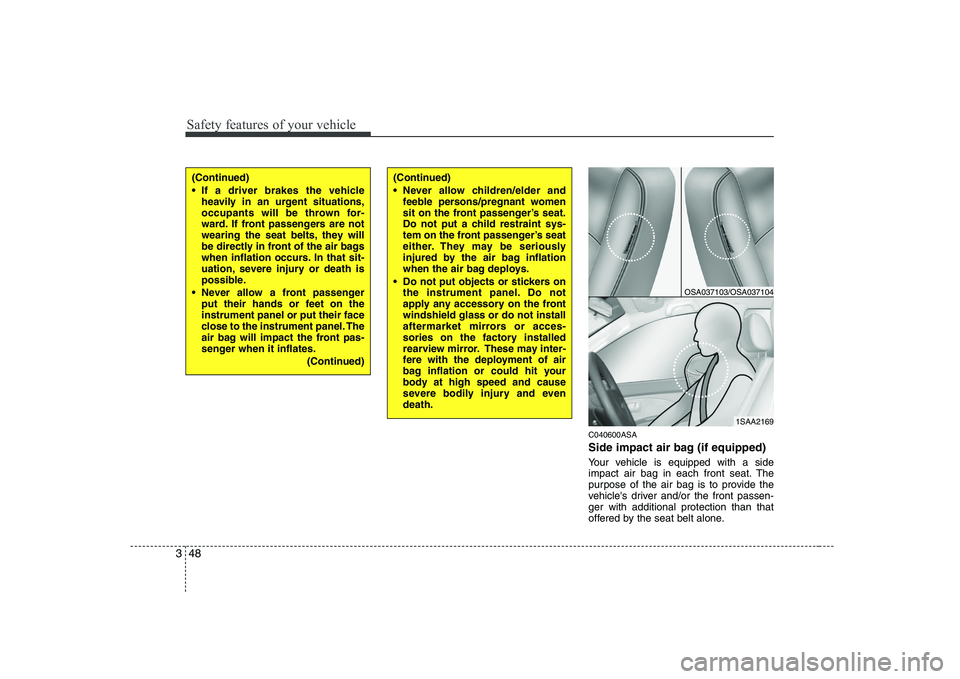
Safety features of your vehicle
48
3
C040600ASA
Side impact air bag (if equipped)
Your vehicle is equipped with a side
impact air bag in each front seat. The
purpose of the air bag is to provide the
vehicle's driver and/or the front passen-ger with additional protection than that
offered by the seat belt alone.
1SAA2169
(Continued)
If a driver brakes the vehicle
heavily in an urgent situations,
occupants will be thrown for-
ward. If front passengers are not
wearing the seat belts, they will
be directly in front of the air bags
when inflation occurs. In that sit-
uation, severe injury or death is
possible.
Never allow a front passenger put their hands or feet on theinstrument panel or put their face
close to the instrument panel. The
air bag will impact the front pas-
senger when it inflates.
(Continued)(Continued)
Never allow children/elder andfeeble persons/pregnant women
sit on the front passenger’s seat.
Do not put a child restraint sys-
tem on the front passenger’s seat
either. They may be seriously
injured by the air bag inflation
when the air bag deploys.
Do not put objects or stickers on the instrument panel. Do not
apply any accessory on the frontwindshield glass or do not install
aftermarket mirrors or acces-
sories on the factory installed
rearview mirror. These may inter-
fere with the deployment of air
bag inflation or could hit your
body at high speed and cause
severe bodily injury and evendeath.
OSA037103/OSA037104
Page 68 of 335
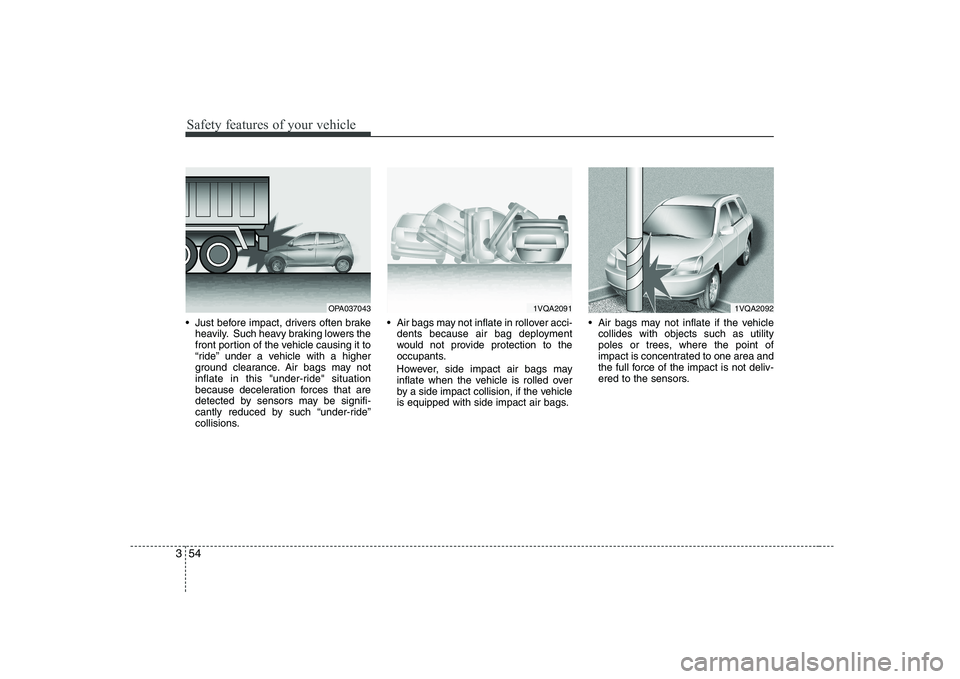
Safety features of your vehicle
54
3
Just before impact, drivers often brake
heavily. Such heavy braking lowers the
front portion of the vehicle causing it to
“ride” under a vehicle with a higher
ground clearance. Air bags may not
inflate in this "under-ride" situation
because deceleration forces that are
detected by sensors may be signifi-
cantly reduced by such “under-ride”
collisions. Air bags may not inflate in rollover acci-
dents because air bag deployment
would not provide protection to the
occupants.
However, side impact air bags may inflate when the vehicle is rolled over
by a side impact collision, if the vehicle
is equipped with side impact air bags. Air bags may not inflate if the vehicle
collides with objects such as utility
poles or trees, where the point of
impact is concentrated to one area and
the full force of the impact is not deliv-
ered to the sensors.
OPA0370431VQA20911VQA2092
Page 80 of 335
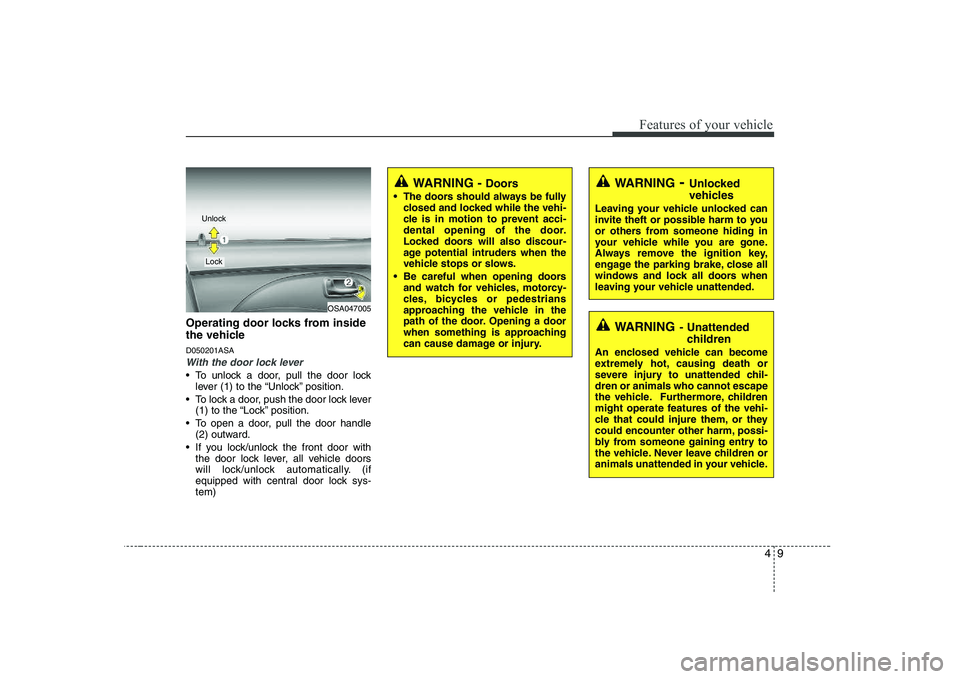
49
Features of your vehicle
Operating door locks from inside
the vehicle D050201ASA
With the door lock lever
To unlock a door, pull the door locklever (1) to the “Unlock” position.
To lock a door, push the door lock lever (1) to the “Lock” position.
To open a door, pull the door handle (2) outward.
If you lock/unlock the front door with the door lock lever, all vehicle doors
will lock/unlock automatically. (if
equipped with central door lock sys-tem)
WARNING - Doors
The doors should always be fully closed and locked while the vehi-
cle is in motion to prevent acci-
dental opening of the door.
Locked doors will also discour-
age potential intruders when the
vehicle stops or slows.
Be careful when opening doors and watch for vehicles, motorcy-
cles, bicycles or pedestrians
approaching the vehicle in the
path of the door. Opening a door
when something is approaching
can cause damage or injury.WARNING - Unlocked
vehicles
Leaving your vehicle unlocked can
invite theft or possible harm to you
or others from someone hiding in
your vehicle while you are gone.
Always remove the ignition key,
engage the parking brake, close all
windows and lock all doors when
leaving your vehicle unattended.
WARNING - Unattended
children
An enclosed vehicle can become
extremely hot, causing death or
severe injury to unattended chil-dren or animals who cannot escape
the vehicle. Furthermore, children
might operate features of the vehi-
cle that could injure them, or they
could encounter other harm, possi-
bly from someone gaining entry to
the vehicle. Never leave children or
animals unattended in your vehicle.
OSA047005
Lock
Unlock
Page 100 of 335
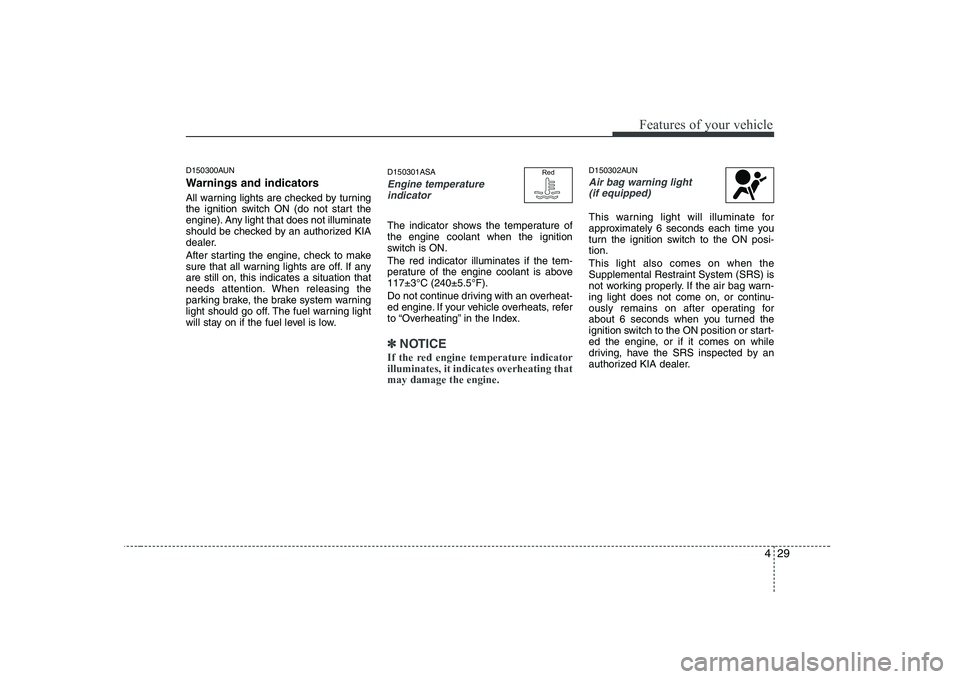
429
Features of your vehicle
D150300AUN
Warnings and indicators
All warning lights are checked by turning
the ignition switch ON (do not start the
engine). Any light that does not illuminate
should be checked by an authorized KIA
dealer.
After starting the engine, check to make
sure that all warning lights are off. If anyare still on, this indicates a situation that
needs attention. When releasing the
parking brake, the brake system warning
light should go off. The fuel warning light
will stay on if the fuel level is low.D150301ASA
Engine temperature
indicator
The indicator shows the temperature of the engine coolant when the ignition
switch is ON. The red indicator illuminates if the tem-
perature of the engine coolant is above117±3°C (240±5.5°F).
Do not continue driving with an overheat-
ed engine. If your vehicle overheats, refer
to “Overheating” in the Index.
✽✽ NOTICE
If the red engine temperature indicator illuminates, it indicates overheating thatmay damage the engine.
D150302AUN
Air bag warning light (if equipped)
This warning light will illuminate for
approximately 6 seconds each time you
turn the ignition switch to the ON posi-tion. This light also comes on when the
Supplemental Restraint System (SRS) is
not working properly. If the air bag warn-
ing light does not come on, or continu-
ously remains on after operating for
about 6 seconds when you turned the
ignition switch to the ON position or start-
ed the engine, or if it comes on while
driving, have the SRS inspected by an
authorized KIA dealer.
Red